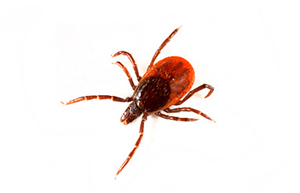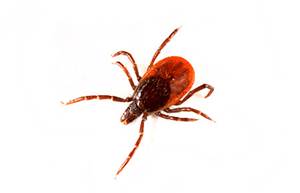

Tick Prevention
Ticks Overview

Ticks are parasitic arachnids ranging from about two millimeters to as large as ten millimeters in size. The most common concern in our region is Ixodes scapularis, also known as the deer tick or the black-legged tick. These parasites are known mostly as the main vector for the spread of Lyme disease in North America, making tick prevention and tick pest control crucial services.
Where are Ticks Found?

If you thought only those who spent time in the woods were at risk to pick up the tiny deer tick, you might be surprised to know that this arachnid is very much at home on backyard shrubs and blades of grass.
While they prefer these grassy and wooded areas, they are always on the search for blood, looking to latch onto humans or animals. Ticks also prefer areas with mice, which are a common host, so rodent control is also beneficial in keeping down tick populations. No matter the location, they are most commonly found during tick season which runs from April to November.
What Makes Ticks Harmful?

The main concern with deer ticks is their ability to spread Lyme disease. While there is no way of knowing exactly how many people contract Lyme disease each year, a recent report estimates the figure to be around 476,000. The majority of Lyme disease cases are reported in the summer months, coinciding with the months that deer ticks are most likely to bite humans.
And now, the deer tick has been implicated in the transmission of other diseases. Foremost among these is Babesiosis, a malaria-like illness.
Different species of ticks can spread different diseases, like Rocky Mountain Spotted Fever and tularemia. Tick paralysis can also result in the death of children and animals if not detected and resolved in a timely manner.
Signs Ticks are Present in Your Home or Facility

You can tell when you are dealing with a tick infestation simply by finding large numbers of ticks on yourself or your pets. Ticks require blood to survive and produce offspring, so they will attach themselves to any sources they can find. While these pests can move quickly, you will most likely find them on areas of the body that are warm, moist and constricted like under armpits and on the groin or scalp.
The tick will bite and latch itself onto your skin, which is why it’s always important to scan your body after being in an area known or suspected to have ticks. This is a good practice for tick prevention and tick removal.
Treatment

If you’re wondering how to remove ticks permanently, Braman Termite & Pest Elimination now offers a tick removal process to help reduce the chances of your family and pets becoming a victim of these insidious pests. We will apply residual sprays or granules periodically during tick season along the areas where lawn transitions to woods, as well as in plant beds and garden areas. This service will greatly reduce the population of deer ticks and dog ticks around your property.
Alternatively, for those who would like to use tick control products instead of insecticide sprays, Braman offers the Tick Control System, a method developed by the Centers for Disease Control and Prevention (CDC), consisting of a plastic station that contains a food attractant and an insecticide wick. Deer ticks on small mammals are killed as they come in contact with the wick. This system has proven to be very effective when used consistently for a minimum of two years.
We also offer our specialized Mosquito and Tick Protection Plan™, in which we will assess your home and property to identify any breeding grounds or at-risk areas for these pests. This protection starts in early spring and lasts until late fall and special rates are available for existing members of our Braman MultiPest Plan.
Contact the experts at Braman today to help you reduce your risk of exposure!

Tell us about your pest problem. We can provide a free estimate over the phone.
Call Braman 24/7 at 800-338-6757

